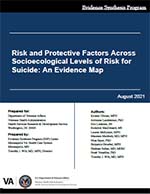
|
Prepared by: Recommended citation: |
Download PDF: Complete Report, Executive Summary, Report, Appendices
Most studied risk factors for suicide attempts and deaths in general populations of US Veterans or Active Duty Military personnel were at the individual or relationship level of the Socio-Ecological Model. Prior suicide ideation or attempts, depression/anxiety, and substance use were consistently associated with attempts or suicide. Community level factors were less studied. No studies evaluated societal-level factors. Evidence was extensive but most studies were categorized high risk of bias. Higher quality studies are needed.
Suicide remains a critical public health concern, as US suicide rates increased by 33% from 1999 to 2019. Adjusted suicide rates among US Veterans are 1.5 times the general population. VA Health Services Research and Development commissioned this review to develop research priorities and inform research funding. We prepared an evidence map of risk and protective factors in general populations of US Veterans and active duty military identified since 2011 using the socio-ecological suicide model.
Among general populations of Veterans or Active Duty Military populations, not known to be at increased risk of suicide, information from prospective cohort and low risk of bias studies suggested a history of prior suicide ideation or attempts, depression/anxiety, and substance, alcohol, or tobacco use are consistently predictive of, or associated with, suicide attempts and suicide. PTSD was not consistently associated with suicide. Most information was related to individual risk factors and no studies reported on societal level risk or protective factors. We urge caution in interpretation and application of our findings. Most results came from moderate risk of bias retrospective cohort studies. Overall evidence certainty was limited, due in part to study design, variation across studies in risk factor definitions and categorization, uncertainty in models and variables used to assess the independent effect of reported factors and the lack of predictor reporting.
Risk and Protective Factors across Socioecological Levels of Risk for Suicide: An Evidence Map (Management eBrief)